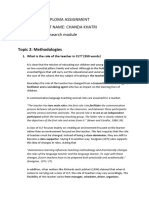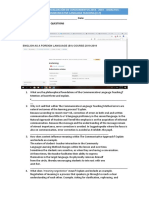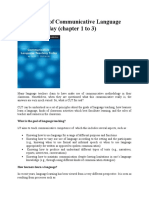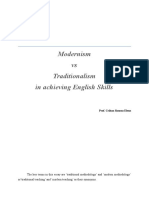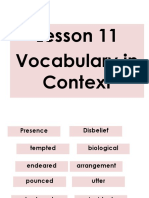0 ratings0% found this document useful (0 votes)
0 views.......
.......
Uploaded by
Najma KousarAssignement
Copyright:
© All Rights Reserved
Available Formats
Download as DOCX, PDF, TXT or read online from Scribd
.......
.......
Uploaded by
Najma Kousar0 ratings0% found this document useful (0 votes)
0 views3 pagesAssignement
Copyright
© © All Rights Reserved
Available Formats
DOCX, PDF, TXT or read online from Scribd
Share this document
Did you find this document useful?
Is this content inappropriate?
Assignement
Copyright:
© All Rights Reserved
Available Formats
Download as DOCX, PDF, TXT or read online from Scribd
Download as docx, pdf, or txt
0 ratings0% found this document useful (0 votes)
0 views3 pages.......
.......
Uploaded by
Najma KousarAssignement
Copyright:
© All Rights Reserved
Available Formats
Download as DOCX, PDF, TXT or read online from Scribd
Download as docx, pdf, or txt
You are on page 1of 3
BS English Applied Linguistics
Applied Linguistics (ENG522)
Fall 2024
Assignment No. 1
Total Marks: 20
Q. Choose one language teaching method and analyse its
advantages and challenges in practice. Provide examples of how
you would implement this method in your teaching, considering
the specific needs and backgrounds of your students.
One commonly used language teaching method is the Communicative
Language Teaching (CLT) approach. CLT emphasizes interaction as both
the means and the ultimate goal of learning a language, focusing on real-
life communication skills rather than only grammar or vocabulary
memorization. This method has many advantages and challenges when
applied in practice.
Advantages of CLT
1. Focus on Communication Skills: CLT prioritizes the ability to
communicate effectively, helping students develop practical
language skills they can use in real-world settings. This approach
emphasizes fluency and comprehension, making it useful for
students needing language skills for travel, work, or social
interactions.
2. Engagement and Motivation: CLT involves interactive activities
like role-plays, group discussions, and simulations, which make
lessons effective and engaging. Such activities encourage active
participation, helping students feel more interested in their learning.
3. Cultural Awareness: CLT often includes cultural elements,
teaching students not only the language but also cultural norms and
nuances. This helps learners understand the social and cultural
contexts of the language, which is important for meaningful
communication.
4. Personalized Learning: CLT is flexible and to students’ needs.
Teachers can performs activities and topics based on students’
interests, backgrounds, and goals, creating a more learning
experience.
Challenges of CLT
1. Focus on Fluency Over Accuracy: CLT focus on fluency, which
can sometimes lead to a lack of focus on grammar or structural
accuracy. Students may develop bad habits or misunderstand
grammatical rules that are overlooked in favour of communication.
2. Teacher Training and Preparation: Effective CLT requires
teachers to be skilled in managing group dynamics and creating
meaningful, communicative activities. Teachers without sufficient
training or resources may struggle to implement CLT effectively.
3. Assessment Difficulties: Assessing communicative competence is
more complex than traditional assessments. It requires observing
students’ language use in context, which can be subjective and
time-consuming.
4. Challenges for Shy or Introverted Students: CLT relies heavily
on group interaction, which can be intimidating for shy or
introverted learners. These students may feel uncomfortable
speaking in front of others, avoid their participation and progress.
Implementing CLT in the Classroom
Example: Teaching a Class with Diverse Language Backgrounds
If I were teaching English to a group of adult learners from various cultural
and linguistic backgrounds, I would modify CLT to meet their specific
needs and contexts. Many of these students might need English for
practical, everyday use, while others might require it for academic or
professional purposes. Here’s how I might implement CLT in this context:
1. Role-Play and Real-Life Scenarios: I would use role-plays to
simulate real-life situations such as ordering food in a restaurant,
asking for directions, or attending a job interview. For instance, I
might assign roles in a “doctor’s office” scenario, where students
practice describing symptoms or understanding instructions. These
activities allow students to practice useful vocabulary and sentence
structures in a meaningful context.
2. Small Group Discussions: To encourage participation among all
students, I would organize small group discussions on familiar
topics. This helps students practice speaking while also learning
about each other’s cultures, fostering a sense of community in the
classroom. I might provide prompts or guiding questions to support
students who may be more reserved.
3. Task-Based Activities: I could assign task-based activities such as
planning a group trip, organizing an event, or solving a problem
together. These tasks require students to communicate effectively
to complete the activity. For example, if the task is to plan a trip,
students would need to discuss destinations, budget, activities, and
schedule, practicing various communicative functions (asking
questions, giving opinions, negotiating).
4. Error Correction and Feedback: To address the challenge of
grammatical accuracy, I would provide corrective feedback during
communicative activities. For instance, if a student makes an error
in tense while describing past events, I might reformulate the
sentence correctly without interrupting the flow of conversation,
allowing them to learn through example. Additionally, I could use
follow-up sessions focused on common mistakes observed during
activities.
5. Encouraging Cultural Awareness: CLT encourages learning
language in its cultural context. I would introduce students to
cultural idioms, gestures, and conversational norms in English-
speaking countries. For example, in a lesson on “small talk,” I might
discuss typical conversation starters in English and contrast these
with conversation norms in the students’ cultures, which can lead to
meaningful discussions on cultural differences.
Conclusion
Communicative Language Teaching is highly effective for building
practical communication skills, fostering cultural awareness, and engaging
students through interactive learning. However, it requires careful
planning to address challenges like balancing fluency and accuracy,
supporting introverted learners, and ensuring effective assessment. By
tailoring activities to the students’ specific needs and backgrounds,
teachers can tackle the strengths of CLT while addressing its challenges to
create a balanced and effective language learning experience.
You might also like
- Tefl Research ModuleDocument12 pagesTefl Research Modulensaxena03No ratings yet
- Countable and Uncountable Nouns Lesson PlanDocument7 pagesCountable and Uncountable Nouns Lesson PlanAndrea Tamas100% (2)
- Words Their Way Elementary Spelling Inventory Feature GuideDocument18 pagesWords Their Way Elementary Spelling Inventory Feature GuideJaimi FittallNo ratings yet
- Upskilling-Communicative Language Teaching inputsDocument23 pagesUpskilling-Communicative Language Teaching inputsSamuel SacapanoNo ratings yet
- ENG522 Assignment Sample SolutionDocument2 pagesENG522 Assignment Sample Solutionmuhammadrafiqe589No ratings yet
- Mrk_Fall 2024_ENG522_1_BC230207596Document4 pagesMrk_Fall 2024_ENG522_1_BC230207596ayeshavu986No ratings yet
- Applying the Communicative Language Teaching ApproachDocument4 pagesApplying the Communicative Language Teaching ApproachSandronNo ratings yet
- CLT BasicDocument3 pagesCLT BasicmanaxhilNo ratings yet
- Compilation of ApproachDocument25 pagesCompilation of ApproachKenzzy DazheriaNo ratings yet
- Reflection on Applying the Communicative Language TeachingDocument4 pagesReflection on Applying the Communicative Language TeachingMaha AlsudaidNo ratings yet
- ENG522Document3 pagesENG522eshamohsin277No ratings yet
- Quiz - S7Document1 pageQuiz - S7Doris Eliana Incacutipa HuaccaNo ratings yet
- Quiz - S7Document1 pageQuiz - S7Doris Eliana Incacutipa HuaccaNo ratings yet
- Self Study ForbesDocument13 pagesSelf Study ForbesjameliafembersNo ratings yet
- Communicative ApproachDocument9 pagesCommunicative ApproachAmal OmarNo ratings yet
- CLT and TBLTDocument6 pagesCLT and TBLTRajibul Islam RezaNo ratings yet
- Communicative Learning Teaching ...Document4 pagesCommunicative Learning Teaching ...ozypics6858No ratings yet
- What Is The Communicative Approach?Document5 pagesWhat Is The Communicative Approach?Brenda PalaciosNo ratings yet
- 1the Principles of Communicative Language TeachingDocument2 pages1the Principles of Communicative Language TeachingSimeonov AlinaNo ratings yet
- fundamentos resumenDocument5 pagesfundamentos resumenbarbypuchettaNo ratings yet
- School Experience 2012-1Document47 pagesSchool Experience 2012-1Andreea BudeanuNo ratings yet
- Topic 14. EFLDocument16 pagesTopic 14. EFLAntonioNo ratings yet
- Elt 02 2.0Document3 pagesElt 02 2.0Magsino KhyllNo ratings yet
- Activity and CommunicativeDocument11 pagesActivity and CommunicativeSafaa Mohamed Abou KhozaimaNo ratings yet
- Communication ApproachDocument7 pagesCommunication Approachbulbulkarn0418No ratings yet
- Diploma Exam TESOLDocument12 pagesDiploma Exam TESOLSwathiGoud NathiNo ratings yet
- Communicative Language Teaching WorksheetDocument3 pagesCommunicative Language Teaching WorksheetOz OxNo ratings yet
- CLT Report and Answer Realated QuestionDocument7 pagesCLT Report and Answer Realated QuestionNgan NguyenNo ratings yet
- REFLECTION-PAPER - Cooperative Language TeachingDocument3 pagesREFLECTION-PAPER - Cooperative Language Teachingjheb2095No ratings yet
- Communicative ActivitiesDocument7 pagesCommunicative ActivitiesCristina RusuNo ratings yet
- ELT Assignment 4th SemesterDocument7 pagesELT Assignment 4th SemesterAio AlzaidanyNo ratings yet
- Racticum Instruction TeachingDocument19 pagesRacticum Instruction TeachingParthiva SinhaNo ratings yet
- ACFrOgB0xFNrzwLE39HukyQhvK1tr5hj 4 XPp8GUOVfXUU1YmIdIFrV2ngrRhwl6saxEr4jLqhOyi47TPH4k8a nQt8t GPBOv2SwTpQK-GjoL8O8g6rmnKGTXR3UbOM1cdUCYnIHith8Tnnw7gDocument9 pagesACFrOgB0xFNrzwLE39HukyQhvK1tr5hj 4 XPp8GUOVfXUU1YmIdIFrV2ngrRhwl6saxEr4jLqhOyi47TPH4k8a nQt8t GPBOv2SwTpQK-GjoL8O8g6rmnKGTXR3UbOM1cdUCYnIHith8Tnnw7gDariia KondratiukNo ratings yet
- Lecture 03 Language teaching approaches and methods- post method pedagogyDocument5 pagesLecture 03 Language teaching approaches and methods- post method pedagogynessrinedahmounNo ratings yet
- #2 Canale and SwainDocument5 pages#2 Canale and SwainKRISTELLE COMBATERNo ratings yet
- Chintya Zahra 0050 5B Exercisis 2 MethodDocument3 pagesChintya Zahra 0050 5B Exercisis 2 Methodchintyazwatul4No ratings yet
- Lesson 5 EditedDocument5 pagesLesson 5 EditedPinky MangueraNo ratings yet
- Crafting Sticky Curriculum - Strategies For Effective TeachingDocument6 pagesCrafting Sticky Curriculum - Strategies For Effective TeachingJonathan AcuñaNo ratings yet
- The Notional-Functional SyllabusDocument5 pagesThe Notional-Functional SyllabusKhurram MalikNo ratings yet
- CLT LinguisticsDocument5 pagesCLT LinguisticsMehboob KhalidNo ratings yet
- English Didactics Exercises RetificadoDocument2 pagesEnglish Didactics Exercises RetificadoWilliamNo ratings yet
- Thesis From ICCTDocument74 pagesThesis From ICCTLeo Estrella PlacidoNo ratings yet
- Chanda Khatri Diploma AssignmentDocument14 pagesChanda Khatri Diploma Assignmentchanda khatri100% (2)
- Lad,Cblt,CllDocument6 pagesLad,Cblt,CllArchana MohanNo ratings yet
- List of Exam Questions 2024 MethodologyDocument51 pagesList of Exam Questions 2024 MethodologyMarta BernykNo ratings yet
- Asian College of Teachers: Diploma AssignmentDocument18 pagesAsian College of Teachers: Diploma AssignmentAnjali Tigga67% (3)
- Chương 3 - ELT (Competency-Based Language Teaching)Document5 pagesChương 3 - ELT (Competency-Based Language Teaching)tanminhng684No ratings yet
- Communicative Language Teaching WorksheetDocument3 pagesCommunicative Language Teaching WorksheetOz OxNo ratings yet
- Elements of Communicative Learning TaskDocument10 pagesElements of Communicative Learning TaskFernandoOdinDivinaNo ratings yet
- Module-Language Learning Materials DevelopmentDocument7 pagesModule-Language Learning Materials DevelopmentLyn PalmianoNo ratings yet
- Module in Approaches For Language Arts TeachingDocument6 pagesModule in Approaches For Language Arts TeachingrosevicabangayNo ratings yet
- LessonDocument3 pagesLessonjohnboscookwir3No ratings yet
- Methods of Teaching Thursday 12/8/2020: The Principles of GTMDocument6 pagesMethods of Teaching Thursday 12/8/2020: The Principles of GTMdunia duniaNo ratings yet
- Notes TBLTDocument5 pagesNotes TBLTsinemgulergunNo ratings yet
- A. Communicative Language TeachingDocument7 pagesA. Communicative Language TeachingilhamNo ratings yet
- A Summary of Communicative Language Teaching TodayDocument14 pagesA Summary of Communicative Language Teaching TodayAisyah PutriNo ratings yet
- Competency Based Language TeachingDocument6 pagesCompetency Based Language TeachingSolin SkuNo ratings yet
- Communicative Language Teaching (CLT)Document7 pagesCommunicative Language Teaching (CLT)mnbvfgtr5432plkjihyuuytyrerNo ratings yet
- ModernismDocument7 pagesModernismSimona SymonyciNo ratings yet
- ENG518 Lesson 20Document3 pagesENG518 Lesson 20Najma KousarNo ratings yet
- Lesson 27Document2 pagesLesson 27Najma KousarNo ratings yet
- FallDocument2 pagesFallNajma KousarNo ratings yet
- ENG510 Midterm Short Notes Download (VUStudentspk.com)Document11 pagesENG510 Midterm Short Notes Download (VUStudentspk.com)Najma KousarNo ratings yet
- SC4e TG2 U1Document12 pagesSC4e TG2 U1Ratchakrit SuksaleeNo ratings yet
- EML21 Module 1 PacketDocument14 pagesEML21 Module 1 PacketvravoninjatovoNo ratings yet
- Digital Information and Media LiteracyDocument15 pagesDigital Information and Media LiteracyudontneedtoknowNo ratings yet
- Entrepreneurship Individual AssDocument6 pagesEntrepreneurship Individual Ass杨盈盈No ratings yet
- Nabiha Atiquzzaman LMDocument1 pageNabiha Atiquzzaman LMapi-458692431No ratings yet
- Types of MeaningDocument33 pagesTypes of Meaningsintiatampubolon109No ratings yet
- Chapter 5 - Exercises (Ko Quiz)Document3 pagesChapter 5 - Exercises (Ko Quiz)k60.2112343021No ratings yet
- 拼音pptDocument11 pages拼音pptJoanna Liu0% (1)
- STSE Class 10 LCT Question Paper and Solutions 2022Document10 pagesSTSE Class 10 LCT Question Paper and Solutions 2022NikeNo ratings yet
- Spoken Vs Written Discourse 2Document5 pagesSpoken Vs Written Discourse 2Maham ArshadNo ratings yet
- Chatgpt For Digital MarketersDocument7 pagesChatgpt For Digital Marketerslokopod551100% (2)
- RPH Catch Up Plan Minggu 37Document10 pagesRPH Catch Up Plan Minggu 37PDPPTESLA062021 Nadiah Binti LasuanNo ratings yet
- L3 Position Paper GuidelinesDocument2 pagesL3 Position Paper Guidelinesvargas57262No ratings yet
- Literature Review PresentationDocument11 pagesLiterature Review PresentationJINKYMarie ABELLANo ratings yet
- ENGLISH SYLLABUS 2010 Edition, For Ordinary Level: Form OneDocument8 pagesENGLISH SYLLABUS 2010 Edition, For Ordinary Level: Form OnehanspopeNo ratings yet
- Course Plan - 23ENG101Document4 pagesCourse Plan - 23ENG101Raja RamNo ratings yet
- Sat Drill Test 1Document8 pagesSat Drill Test 1Dương HồngNo ratings yet
- Lesson 11 - Vocabulary XIDocument14 pagesLesson 11 - Vocabulary XItyasNo ratings yet
- I. Objectives: Lesson PlanDocument4 pagesI. Objectives: Lesson PlanMargie JavierNo ratings yet
- Pre Teach VocabDocument3 pagesPre Teach Vocabsaeed jamaliNo ratings yet
- Introductory Lectures To The English Phonetics and PhonologyDocument9 pagesIntroductory Lectures To The English Phonetics and PhonologyKhawla AdnanNo ratings yet
- DLL ENG8 1STQ 8th WeekDocument9 pagesDLL ENG8 1STQ 8th WeekJulievence Fabro YamalaNo ratings yet
- The Importance of ProofreadingDocument1 pageThe Importance of ProofreadingShahed alaa AlsadouniNo ratings yet
- IMPERATIVEDocument10 pagesIMPERATIVEqaireen syafaNo ratings yet
- Lesson Plan-Writing SkillsDocument2 pagesLesson Plan-Writing SkillsTenh Ching LingNo ratings yet
- Suggestopedia: Made by Kryvonis Kateryna 3 Year Student, Filol2018-2Document15 pagesSuggestopedia: Made by Kryvonis Kateryna 3 Year Student, Filol2018-2Катя КривоносNo ratings yet
- Unit 3 - Assignment 1Document29 pagesUnit 3 - Assignment 1JackNo ratings yet
- Lesson 3Document5 pagesLesson 3Chia-Lin ChuangNo ratings yet











































